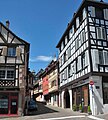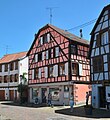Barr
| Barr | ||
|---|---|---|

|
|
|
| region | Grand Est | |
| Department | Bas-Rhin | |
| Arrondissement | Sélestat-Erstein | |
| Canton | Obernai | |
| Community association | Pays de Barr | |
| Coordinates | 48 ° 24 ' N , 7 ° 27' E | |
| height | 176-971 m | |
| surface | 20.61 km 2 | |
| Residents | 7,238 (January 1, 2017) | |
| Population density | 351 inhabitants / km 2 | |
| Post Code | 67140 | |
| INSEE code | 67021 | |
| Website | http://www.barr.fr | |
 Town Hall Square ( Place de l'Hôtel de ville ) |
||
Barr is a French commune with 7,238 inhabitants (as of January 1, 2017) in the Bas-Rhin department in the Grand Est region (until 2015 Alsace ). It belongs to the Arrondissement Sélestat-Erstein and the Canton of Obernai .
geography
The small town of Barr is located at the outlet of the Kirneck from the Vosges into the Upper Rhine Plain , about 17 kilometers north of Sélestat and 25 kilometers southwest of Strasbourg . The heavily forested municipal area extends far into the Vosges to the source of the Kirneck.
Barr's neighboring communities are Heiligenstein in the north (with Landsberg Castle ), Gertwiller in the east, Zellwiller in the south-east, Saint-Pierre and Mittelbergheim in the south, Andlau in the south-west, Le Hohwald in the west and Ottrott and Saint-Nabor in the north-west.
history
Barr was first mentioned as Barru in 788 , but the settlement of the region has been archaeologically proven since the Bronze Age . Barr was initially an imperial village , but was pledged to the Electoral Palatinate by King Ruprecht on June 6, 1409 , together with Heiligenstein , Gertweiler , Goxweiler , Oberburgheim and Niederburgheim. In 1472, the Barr rule finally came to the Palatinate and was sold to the free imperial city of Strasbourg in 1568 , sharing its fate. In 1790 Barr became part of France during the Revolution. From 1871 to the end of the First World War , Barr belonged to the German Empire as part of the realm of Alsace-Lorraine and was assigned to the Schlettstadt district in the Lower Alsace district . From August 1940 to November 1944 Barr came under German civil administration ( CdZ ) but never became part of the Nazi Reich.
Population development
| year | 1910 | 1962 | 1968 | 1975 | 1982 | 1990 | 1999 | 2008 | 2013 |
| Residents | 4934 | 4233 | 4268 | 4157 | 4511 | 4839 | 5892 | 6748 | 7137 |
Attractions
Monuments historiques
The buildings in Barr listed as Monument historique include:
- Protestant Church of St. Martin
- Hotel Marco
- Town hall ( Hôtel de ville ): The town hall was built in 1640 on behalf of the city of Strasbourg on the foundations of a medieval castle, the Wepfermannsburg , named after a knight Wepfermann from Obernai who lived here. This castle was built in the 13th century and according to legend it was destroyed several times "by the devil" and four times by fire. In August 1444 the Armagnaks (see: Battle of St. Jakob an der Birs ) set fire and on August 22, 1592 the troops of the Cardinal of Lorraine, probably Charles of Lorraine , burned the town and the castle down. In January 1632, during the Thirty Years War , the royal troops of the Harancourt Regiment set fire. In the course of the liberation struggles, the town hall burned down a fourth time on November 28, 1944.
More Attractions
- Witnesses to history stand around Rathausplatz:
- - The restaurant Le Brochet , with this name since the 16th century, is the oldest inn in the village and was mentioned as early as 1514. After the major fire of 1678, the building was rebuilt in 1711 and was used as accommodation for the members of the Revolutionary Court during the French Revolution.
- - On the north side of the square is La Maison du Boucher ("the butcher's house"). It bears the coat of arms with the initials of the owner at the time and the guild symbols of the butcher (beef head and ax). The window pillars are decorated with carved flowers.
- - A square sandstone with the remains of a metal hook was the base for a guillotine in 1793 and can still be seen between the paving stones.
- - A stately renaissance staircase in front of the town hall leads to a canopy supported by two Ionic columns. The tithe levy used to be stored under the stairs.
Economy and Infrastructure
Barr's economy is largely driven by viticulture and tourism. The municipality is on the Alsace Wine Route . In the municipality is the Alsace Grand Cru - Kirchberg vineyard .
Barr station is on the Sélestat – Saverne railway line .
Community partnerships
There has been a partnership with today's Trier district of Olewig since 1963 .
Personalities
- Johann Hermann (1738–1800), French physician, naturalist, zoologist and author
- Richard Hartmann (1809–1878), from 1837 locomotive designer and machine manufacturer in Chemnitz (Saxony), benefactor for Barr
- Joseph Alois Faller (1816–1894), Roman Catholic clergyman and founder of an order
- Émile Bieckert (1837 – around 1913), known as Don Emilio , active as an entrepreneur in Buenos Aires between around 1850 and 1889 (with an ice cream factory and brewery ), after 1889 based in southern France, benefactor for Barr
- Édouard Schuré (1841–1929), philosopher
- Marie Bernhard Haas (1844–1919), doctor and member of the Reichstag
- Martin von Feuerstein (1856–1931), painter and academy professor in Munich
- Fritz Hochstätter (* 1944), botanist
Trivia
The future Kaiser Wilhelm II had his first erotic experience with a Strasbourg love servant in Barr. The meeting with Emilie Klopp († 1894) in September 1879 had a daughter.
literature
- Le Patrimoine des Communes du Bas-Rhin . Flohic Editions, Volume 1, Charenton-le-Pont 1999, ISBN 2-84234-055-8 , pp. 40-49.
Web links
Individual evidence
- ↑ Historical Lexicon of the German Lands: The German Territories from the Middle Ages to the Present, C. H. Beck, 2007, p. 43
- ↑ Register of municipalities in Germany 1900 - Schlettstadt district
- ↑ St. Martin in the Base Mérimée of the French Ministry of Culture (French)
- ^ Hotel "Marco" in the Base Mérimée of the French Ministry of Culture (French)
- ↑ Town Hall in the Base Mérimée of the French Ministry of Culture (French)
- ↑ Alsace Grand Cru single layers
- ↑ Statement on trier.de/-olewig Retrieved on July 24, 2020
- ↑ Revealed: Kaiser Wilhelm's sex scandal (Hamburger Abendblatt 2001)
















